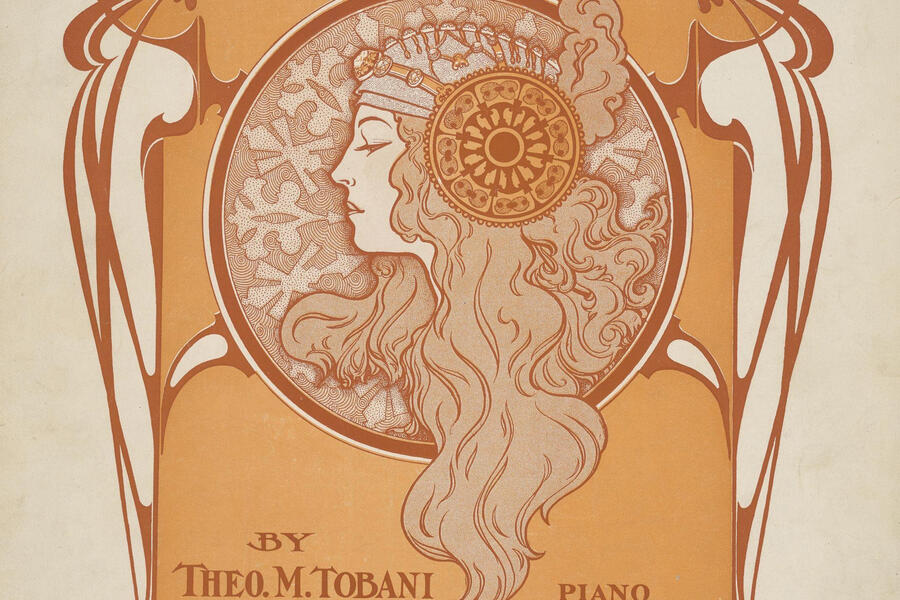In tones of rust and tangerine, a woman's wavy locks trail down, her portrait inlaid like a cameo adorning an ancient Greek pedestal. Her curls mirror the long ribbonlike strands appointing the edges of the ornate art nouveau illustration, below the title: "Salome Dance (Dance of the Seven Veils)." This is the cover of a piece of sheet music for a piano solo written by Theo. M. Tobani, and it's just one of 611 pieces inspired by the Middle East in a collection of 19th- and 20th-century sheet music housed in the Johns Hopkins Sheridan Libraries' Special Collections.
The key word is "inspired." These are primarily American and European perspectives and amalgams— and stereotypes—of cultures, histories, folk tales, and more. Although their titles name-drop places like Egypt, Babylon, and Arabia, they shouldn't be mistaken for artifacts representing specific, actual peoples or their music. The collection includes pieces from 1839 to 1978, a time of heightened Western fascination with the Middle East region, particularly after the 1922 discovery of Tutank?hamen's tomb.
Sam Bessen, the Eleanor and Lester Levy Family Curator of Sheet Music and Popular Culture at Johns Hopkins, has a few handy explanations for puzzled students wondering why sheet music could be relevant to their research in the first place. "Pre-radio, before the record player, before cinema and television, if people wanted to experience music, they had to go see a live performance, or they had to make that music in their home," he says. Sheet music was a major industry during the Tin Pan Alley era, from roughly 1880 to 1940, with publishers pushing quantity over quality. "These covers were designed to be as catchy as possible, so they're kind of an early form of clickbait, where they'll have really catchy titles or subtitles or illustrations to try to get people to buy them."
Special Collections purchased the sheet music in 2011 from Terry Bryan, a collector who amassed these pieces over the course of 25 years while conducting research into "the stereotypical and romanticized image of the Middle East." With colleagues Donald Juedes and Lael Ensor-Bennett, along with Hopkins' digitization team, Bessen processed and cataloged the collection in 2021, making the covers freely accessible on the digital library JSTOR—no institutional affiliation required.
Scrolling through the covers, one encounters scalloped arches, ancient minarets, palm trees, and pyramids—as well as scantily clad, eroticized women, veiled mystics, and racist cartoon depictions of men leading camels or holding court in a harem. Bessen is sensitive to this: The online collection contains a content warning for offensive language and imagery on the covers, and when presenting the collection to students, he gives them the option to not engage with the pieces at all. "A lot of stereotypes were created during this time that haven't gone away," Bessen says. "Part of understanding how we got here is by looking through this music."
These pieces were preserved to be confronted. So far, Bessen has worked with two first-year fellows who studied the collection and analyzed Orientalist tropes and stereotypes; both of their final projects explored how these distorted portrayals have condensed vastly different cultures into disjointed monoliths. One fellow, Vanessa Han, curated a recent online exhibit unraveling the layered manifestations of racism and sexism in several pieces. Another fellow, Noël Da, played through the music and found that many of the songs seemed to only gesture toward Middle Eastern or Asian cultures broadly, with "strange" or "unorthodox" (to Western ears) chords here and there. That's if they even nodded to those cultures at all—some were just ragtime tunes.
A copy of the "Salome Dance" piece is on display with six other facsimiles from the Middle East–inspired collection at the university's Evergreen Museum & Library, part of a new installation focused on the art and influences of the Russian-born Léon Bakst, a set and costume designer who worked for the Ballets Russes dance company. Bakst was a friend of Evergreen resident Alice Warder Garrett's. She championed his work, and, as a thank you, Bakst designed a theater for her Baltimore mansion.
Bakst was influenced by the Orientalist art movement and also incorporated elements from Russian, Middle Eastern, Pueblo, Mexican, Grecian, and Peruvian cultures into his maximalist designs. His work sets a fine example for how various cultural influences can pass through borders and across time like a game of telephone, patterns and themes recycled and reinvented, and sometimes distorted or missing context. It is the work of museums and libraries to fill in that missing material, Evergreen curator Michelle Fitzgerald says.
Also see
Fitzgerald invited Bessen to display sheet music to help contextualize the story of Bakst's and Garrett's interest in the performing arts. The "Salome" sheet music sits on a shelf next to a page from Garrett's scrapbook, where she pasted the description of a 1909 performance of Salome at the Philadelphia Opera House, along with a cutout of the actress in the lead role. "There's always something deeper to [art movements]," Fitzgerald says. "It's gratifying in some ways today that we're conscious of that—it's a means of inviting more people into this Western story."
Many collectors see their objects of interest as windows into the past. "If you want to understand how people were feeling at a certain time, there's a lot you can learn by understanding the music that they were making and the music they were listening to," Bessen says. "Music has just always been a part of who we are."
Posted in Arts+Culture








